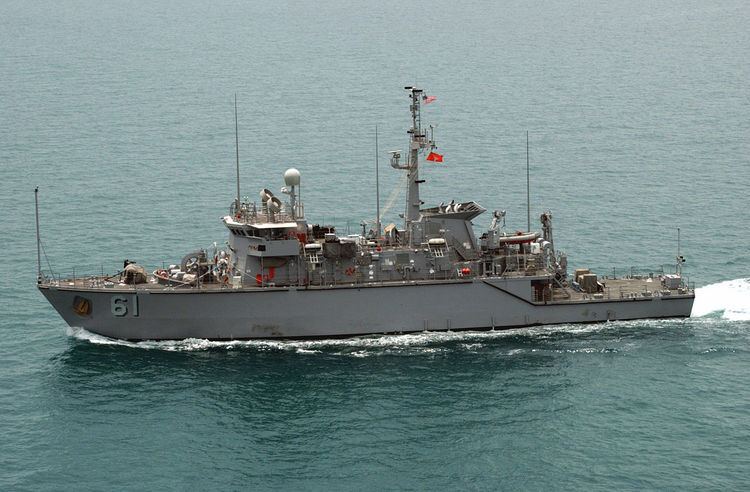Succeeded by None | Preceded by Harkness class Built 1991–1995 | |
 | ||
Builders Intermarine USAAvondale Shipyard Operators U.S. Navy (former)Hellenic NavyEgyptian NavyRepublic of China Navy | ||
The Osprey class are a series of coastal minehunters designed to find, classify, and destroy moored and bottom naval mines from vital waterways. They use sonar and video systems, cable cutters and a mine detonating device that can be released and detonated by remote control. The Osprey class are the world's second largest minehunters (surpassed by the Royal Navy's 60-metre (200 ft) Hunt-class mine countermeasures vessels) to be constructed entirely of fiberglass and designed to survive the shock of underwater explosions. Their primary mission is reconnaissance, classification, and neutralization of all types of moored and bottom mines in littoral areas, harbors and coastal waterways.
Contents
Construction
Twelve minehunter ships were built for the U.S. Navy by Northrop Grumman Ship Systems (formerly Litton Avondale Industries) of New Orleans and Intermarine of Savannah. The ships were commissioned between 1993 and 1999. The ships of this class were named after various types of birds.
The 12 ships are 187 feet 10 inches (57.3 m) long, 34 feet 7 inches (10.5 m) wide, and 70 feet 0 inches (21.3 m) tall. When carrying a full load they displace 904 tonnes (890 long tons; 996 short tons). They have four decks, and have a complement of five officers, four chief petty officers, and 42 enlisted men. They are armed two .50 caliber machine guns. All of the major equipment is suspended from the main deck in glass-reinforced plastic holders, so that in the event of an undersea explosion, it will not be damaged.
They use a AN/SLQ-53 deep sweep mine countermeasures system. It also uses an AN/SQQ-32 Variable Depth Sonar, which is tethered to the front of the bridge, to detects and identifies mines using multiple ping processing. Two AN/UYK-44 computers are also used to classify and detect mines. For surface radar purposes, an AN/SPS-64(V)9 is used. They also use the AN/SLQ-48 mine neutralization system, which is tethered to the ship by a 1.07-kilometre (0.66 mi) long cable. They have two AN/UYQ-31 operator data terminals, which are identical.
They are propelled by two Isotta Franschini ID 36 SS 8V AM diesel engines which drive two Voith Schneider cycloidal propellers generating 1,600 horsepower (1,200 kW), and have three Isotta Fraschini ID 36 diesel generators. They use a single bow thruster, which generates 180 shaft horsepower (130 kW), in order to run silently. They have a max speed of 12 knots (22 km/h), and a maximum operational range of 1,500 nautical miles (2,800 km).
Decommissioning
All of these ships were decommissioned in 2006–07. The Hellenic Navy received two of the Osprey class from the US Navy: Heron, renamed Calypso and Pelican, renamed Euniki. Two more were transferred to the Egyptian Navy: Cardinal, renamed al Sedeeq (MHC-521) and Raven, renamed al Farouk (MHC-524). The sale of Oriole and Falcon to the Republic of China was also authorized.
The U.S. General Services Administration (GS) announced in April 2014 that hull numbers MHC-51, 54, 56, 57, 58, and 62 were up for auction to be sold as an entire lot for "dismantlement purposes only." This contradicted earlier information announcing the sale of some of these vessels to foreign operators. The minehunting role that was to this class will be transferred to Littoral Combat Ships that are equipped with a Mine Counter-Measure model.
